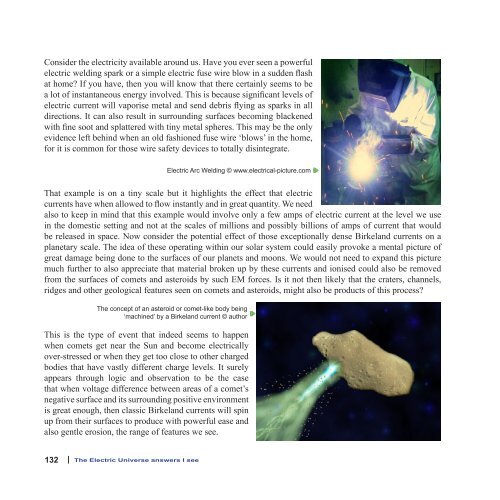A Beginner's View of Our Electric Universe - New
A Beginner's View of Our Electric Universe - New
A Beginner's View of Our Electric Universe - New
You also want an ePaper? Increase the reach of your titles
YUMPU automatically turns print PDFs into web optimized ePapers that Google loves.
Consider the electricity available around us. Have you ever seen a powerful<br />
electric welding spark or a simple electric fuse wire blow in a sudden flash<br />
at home? If you have, then you will know that there certainly seems to be<br />
a lot <strong>of</strong> instantaneous energy involved. This is because significant levels <strong>of</strong><br />
electric current will vaporise metal and send debris flying as sparks in all<br />
directions. It can also result in surrounding surfaces becoming blackened<br />
with fine soot and splattered with tiny metal spheres. This may be the only<br />
evidence left behind when an old fashioned fuse wire ‘blows’ in the home,<br />
for it is common for those wire safety devices to totally disintegrate.<br />
That example is on a tiny scale but it highlights the effect that electric<br />
currents have when allowed to flow instantly and in great quantity. We need<br />
also to keep in mind that this example would involve only a few amps <strong>of</strong> electric current at the level we use<br />
in the domestic setting and not at the scales <strong>of</strong> millions and possibly billions <strong>of</strong> amps <strong>of</strong> current that would<br />
be released in space. Now consider the potential effect <strong>of</strong> those exceptionally dense Birkeland currents on a<br />
planetary scale. The idea <strong>of</strong> these operating within our solar system could easily provoke a mental picture <strong>of</strong><br />
great damage being done to the surfaces <strong>of</strong> our planets and moons. We would not need to expand this picture<br />
much further to also appreciate that material broken up by these currents and ionised could also be removed<br />
from the surfaces <strong>of</strong> comets and asteroids by such EM forces. Is it not then likely that the craters, channels,<br />
ridges and other geological features seen on comets and asteroids, might also be products <strong>of</strong> this process?<br />
The concept <strong>of</strong> an asteroid or comet-like body being<br />
‘machined’ by a Birkeland current © author<br />
This is the type <strong>of</strong> event that indeed seems to happen<br />
when comets get near the Sun and become electrically<br />
over-stressed or when they get too close to other charged<br />
bodies that have vastly different charge levels. It surely<br />
appears through logic and observation to be the case<br />
that when voltage difference between areas <strong>of</strong> a comet’s<br />
negative surface and its surrounding positive environment<br />
is great enough, then classic Birkeland currents will spin<br />
up from their surfaces to produce with powerful ease and<br />
also gentle erosion, the range <strong>of</strong> features we see.<br />
132 | The <strong>Electric</strong> <strong>Universe</strong> answers I see<br />
<strong>Electric</strong> Arc Welding © www.electrical-picture.com


